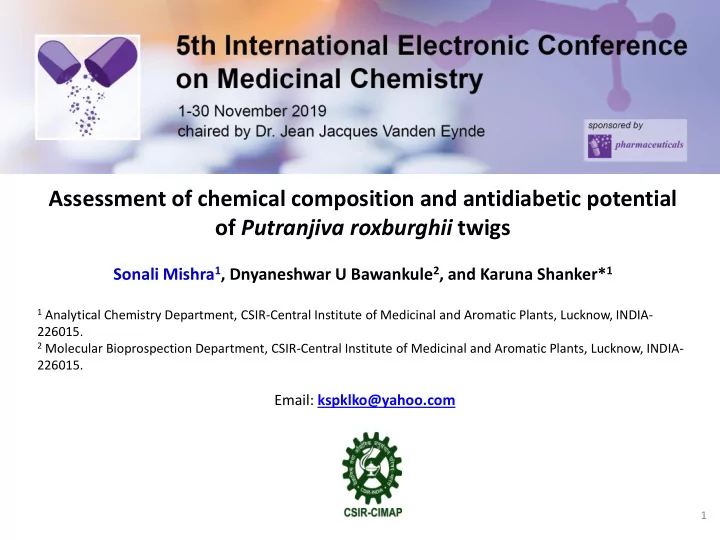

Assessment of chemical composition and antidiabetic potential of Putranjiva roxburghii twigs Sonali Mishra 1 , Dnyaneshwar U Bawankule 2 , and Karuna Shanker* 1 1 Analytical Chemistry Department, CSIR-Central Institute of Medicinal and Aromatic Plants, Lucknow, INDIA- 226015. 2 Molecular Bioprospection Department, CSIR-Central Institute of Medicinal and Aromatic Plants, Lucknow, INDIA- 226015. Email: kspklko@yahoo.com 1
Assessment of chemical composition and antidiabetic potential of Putranjiva roxburghii twigs Glucose uptake assay • Extraction with • Evaluated ethanol Compounds 1 & 2 differences in • Fractionation isolated by Column glucose conc. by liquid-liquid chromatography before and after partitioning culture Isolation from bioactive OH O sample- 1, 5 fraction and 10 µg/ml Putranjiva roxburghii OH twigs and butanol fraction H O At 10 µg/ml OH 2, 4 dihydroxy-5-(hydroxymethyl) benzoic acid ( 1 ) 95.47 ± 8.12 µg/dl OH OH H O 69.76 ± 12.11 µg/dl OH O OH L-quebratichol ( 2 ) 2
Abstract Background: Putranjiva roxburghii belongs to the Putranjivaceae family and usually grow in India, Nepal, Bangladesh and Sri Lanka. Traditionally, leaves and seeds are used for treating fever, inflammation and pain. Aim of the study: The objective of the study is to isolate and characterize the chemical constituents from Putranjiva twigs and evaluate its antidiabetic potential. Methods: The powdered material of twigs extracted with alcohol and partitioned into different fractions. Chemical fingerprint of each fraction was developed by RP-HPLC method. The isolation performed with butanol fraction and two new compounds obtained. The pure compounds assessed for the dose dependent glucose uptake assay on L6 myotubes in Dulbecco modified Eagle medium. Up-regulatory effects of the compounds with insulin and TNF- α expression level have been studied. The isolation from twigs butanol fraction gave two new compounds-2, 4 dihydroxy-5- Results: (hydroxymethyl) benzoic acid (DHMBA) (1) and L-quebrachitol (QBC) (2) of phenolic and cyclitol class respectively. The up-regulation of glucose uptake of the compounds were comparable with insulin and standard drug metformin. Conclusion: The results of present study indicate that plant has varied secondary metabolites with potential antidiabetic activity. However, the plant is not well explored and requires scientific validation in detailed in vivo studies and their mode of action. Keywords: Putranjiva roxburghii ; twigs; phenolic, cyclitol; antidiabetic 3
Introduction • Putranjiva roxburghii is traditionally used in Indian System of Medicine (ISM). • The medicinal use of the tree is mentioned in various Indian literature like- like- Madanpal Nighantu, Kaiyadeva Nighantu etc. • The leaves, bark and seeds are used as refrigerant, analgesic, antipyretic and anti- inflammatory. • The tree is still not explored for antidiabetic actions. Putranjiva roxburghii tree • The glucose uptake alteration affects the metabolism.
Methodology ✓ Cell culture : L6 Cells (Rat-derived Skeletal Muscle Cells ) ✓ L6 myoblast were grown in DMEM (Dulbecco modified Eagle medium, Sigma) supplemented with 10% foetal bovine serum with 1X stabilized antibiotic-antimycotic solution in a CO 2 incubator at 37ºC with 5% CO 2 and 90% relative humidity. ✓ L6 myoblast (2 x 10 5 cells/ml) were subcultured into 96 well and grow for 7 days in 2% FBS until they form myotube. ✓ They were then incubated in KHH buffer (Krebs henseleit- HEPES) containing 11 mM glucose with TNF- α (7 ng/ml) and 1 µM of insulin along with different concentration of extract for 24 hrs. ✓ The glucose uptake was measured using GOD- POD kit. 5
Results and discussion 120 # * 100 80 60 Series1 40 20 0 Healthy cells Insulin(1µM) Insulin+ TNF- α (1µM + 7 ng/ml) TNF- α significantly decreased insulin stimulated glucose uptake by 50% compare to the one with insulin alone. each value represents the Mean ± SEM n=3 p<0.05 # Normal Vs insulin alone, *Insulin Vs Insulin +TNF- α . ANOVA, Tukey’s Multiple Comparison Test 6
TNF- α Sample Insulin Concentration Glucose Uptake (µg/ml) (µg/dl) 31.51 ± 9.59 Normal - - - 166.25 ± 6.18 ε Metformin 1 189.12 ± 11.23 ε Metformin 3 67.78 ± 5.20 DHMBA 1 79.58 ± 5.39 ε DHMBA 5 95.47 ± 8.12 ε DHMBA 10 55.25 ± 8.12 QBC 1 64.26 ± 11.13 QBC 5 69.76 ± 12.11 QBC 10 Each value represents the Mean ± SEM n=3 p<0.05 # Normal Vs insulin alone, *Insulin Vs Insulin +TNF- α; ε Insulin + TNF- α Vs Insulin +TNF +Treatment ANOVA, Tukey’s Multiple Comparision Test. 7
Conclusion • The plant has varied class of secondary metabolites. • It showed promising antidiabetic actions. • The future studies require scientific validation in detailed in vivo studies and their mode of action. 8
Acknowledgements • Department of Science and Technology INDIA, for providing INSPIRE Fellowship (IF-150254) to Sonali Mishra. • Director CSIR-CIMAP for providing research facilities. 9
Recommend
More recommend